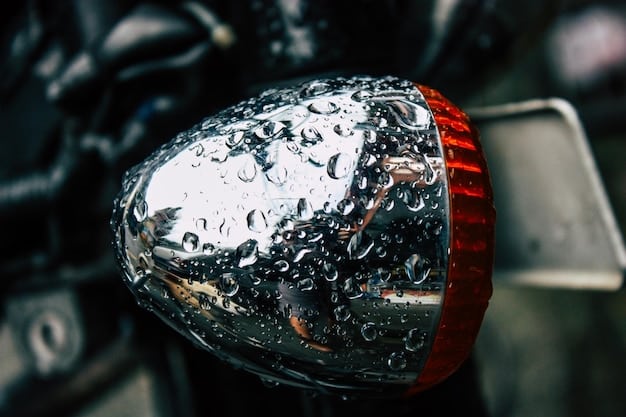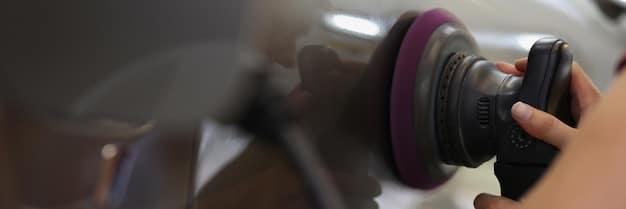Car Detailing: Get a Showroom Shine & Protect Your Car

The art of automotive detailing goes beyond a simple car wash, focusing on meticulous cleaning, correction, and protection to achieve a showroom shine while safeguarding your vehicle’s value and appearance for years to come.
Is your car looking a little dull? Discover the art of automotive detailing, a comprehensive process designed to restore your vehicle’s appearance to its former glory and protect it from the elements. It’s more than just a car wash; it’s an investment in your car’s longevity and aesthetic appeal.
What Exactly Is Automotive Detailing?
Automotive detailing is the process of thoroughly cleaning, correcting, and protecting the various surfaces of a vehicle. Unlike a regular car wash, detailing involves a more meticulous and comprehensive approach.
It’s about paying attention to every nook and cranny, from the paint to the interior upholstery.
The Key Differences Between Detailing and Washing
While both aim to clean a car, detailing goes much further than a simple wash. Detailing focuses on restoring and protecting the vehicle.
- Washing: Primarily removes surface dirt and grime.
- Detailing: Addresses imperfections, protects surfaces, and enhances the overall appearance.
- Time Investment: Washing is quick; detailing requires hours or even days.

Automotive detailing is an investment that enhances the vehicle’s visual appeal and protects its value. It increases personal enjoyment and enhances your vehicle’s value offering various benefits that make it desirable for car enthusiasts willing to upgrade their car care regimen.
The Interior Detailing Process: A Deep Clean
Interior detailing focuses on cleaning and restoring the inside of your car. It includes everything from vacuuming to stain removal.
The goal is to create a clean, fresh, and comfortable environment.
Vacuuming and Surface Cleaning
The first step is a thorough vacuuming of the entire interior, including seats, carpets, and crevices. This removes loose dirt and debris.
Next, surfaces are cleaned with appropriate cleaners to remove stains and grime.
Upholstery and Leather Care
Upholstery and leather require special care to prevent damage and maintain their appearance. Leather conditioners help keep leather supple.
- Fabric Cleaners: Use gentle cleaners to avoid discoloration.
- Leather Conditioners: Apply regularly to prevent cracking.
- Stain Removal: Address stains promptly to improve success rates.
Interior detailing doesn’t just improve the look of your car’s interior, but aids in improving comfort. It helps eliminate odors, dust and allergens, creating a healthier environment inside your vehicle.
Exterior Detailing: Paint Correction and Protection
Exterior detailing aims to restore and protect the car’s paint. This often involves paint correction to remove imperfections.
Protecting the paint from environmental contaminants ensures it lasts.
Washing and Decontamination
The process begins with a thorough wash to remove loose dirt. Decontamination removes embedded contaminants like brake dust and tar.
Clay bars are often used to achieve a smooth surface.
Polishing and Waxing
Polishing removes swirl marks and scratches, revealing a deeper shine. Waxing adds a layer of protection and enhances gloss.
- Polishing Compounds: Vary in aggressiveness for different levels of correction.
- Waxes and Sealants: Offer protection against UV rays, water spots, and other elements.
- Ceramic Coating: A durable alternative that offers long-lasting protection.

Exterior detailing keeps the car looking brand new. Detailing improves the visual appearance, but also prevents damage from weathering and pollutants, saving money in the long run.
Choosing the Right Detailing Products
Selecting the products for automotive detailing is important for achieving the desired results without damaging the vehicle’s surfaces.
Using the right products is a critical task with long lasting benefits.
Understanding Different Types of Cleaners
Different cleaners are formulated for specific surfaces. All-purpose cleaners, glass cleaners, and wheel cleaners each have distinct properties.
Using the wrong cleaner can cause damage or discoloration.
The Importance of pH-Balanced Products
pH-balanced products are gentle and effective. They clean without stripping away protective coatings or causing corrosion.
- Acidic Cleaners: Remove mineral deposits but can damage sensitive surfaces.
- Alkaline Cleaners: Degrease and remove heavy grime, but can be harsh.
- Neutral Cleaners: Safe for most surfaces and general cleaning.
Choosing the right detailing products ensures effective cleaning and protection without causing harm to the vehicle’s surfaces. This decision makes the detailing process worthwhile to ensure it enhances the appearance and longevity of the car.
Tools and Equipment for Professional Detailing
Having the right tools and equipment is crucial for achieving professional-level detailing results. From brushes to polishers.
Different tools and equipment perform particular detailing actions.
Essential Detailing Brushes and Applicators
Brushes are used for cleaning tight spaces and delicate surfaces. Microfiber applicators are ideal for applying waxes and sealants.
The Role of Polishers and Buffers
Polishers remove paint imperfections, while buffers enhance shine. Dual-action polishers are safer for beginners.
- Foam Pads: Vary in density; use the right one for the task.
- Microfiber Cloths: Lint-free and gentle for wiping surfaces.
- Pressure Washer: Enhances cleaning efficiency; use with care to avoid damage.
Equipping yourself with the appropriate tools and equipment is essential for effective and efficient detailing. Each instrument helps to perform a specific task, together boosting the detailing and overall quality. Utilizing the right tools produces great results.
Maintaining Your Car’s Showroom Shine
Maintaining a showroom shine requires regular care and attention. Routine washing and protection are key.
Following a maintenance schedule can help prevent further damage.
Regular Washing and Drying Techniques
Wash your car regularly to remove dirt and grime before they can cause damage. Use the two-bucket method to avoid scratching the paint.
Drying techniques prevent water spots.
Protecting Your Investment Long-Term
Apply wax or sealant to protect the paint from UV rays and environmental contaminants. Regularly inspect and address any imperfections.
- Touch-Up Paint: Address chips and scratches promptly.
- Covering: Use a car cover when parked outdoors to minimize exposure.
- Detailing Schedule: Establish a regular detailing schedule.
Maintenance practices help to extend the car’s beauty, while also saving money by preventing costly damage and repairs. Long term value is the main goal to enhance the driving experience with a well-maintained car.
| Key Point | Brief Description |
|---|---|
| ✨ Detailing vs. Washing | Detailing restores & protects; washing just cleans dirt. |
| 🛡️ Paint Protection | Waxing/sealants guard against UV rays & contaminants. |
| 🧽 Interior Care | Vacuum, clean, & condition to keep the interior fresh. |
| 🛠️ Essential Tools | Brushes, polishers, & microfiber cloths are crucial. |
Frequently Asked Questions (FAQs)
▼
Detailing frequency depends on your environment and usage. A full detail every 4-6 months is generally recommended, with regular washes in between.
▼
You can detail your car, but professional detailers have specialized tools and expertise. DIY can save money, but pros offer superior results.
▼
Paint correction involves removing imperfections like swirl marks and scratches from the paint surface through polishing, restoring its original shine.
▼
Ceramic coating provides long-lasting protection against UV rays, scratches, and environmental contaminants. It also makes washing easier and enhances gloss.
▼
Use window tints, sunshades, and interior protectants to guard against sun damage. Regular conditioning of leather and vinyl surfaces helps prevent cracking.
Conclusion
Mastering the art of automotive detailing is an investment in your vehicle’s appearance and longevity. Whether you choose to DIY or hire a professional, consistently maintaining your car will keep it looking its best and preserve its value.





